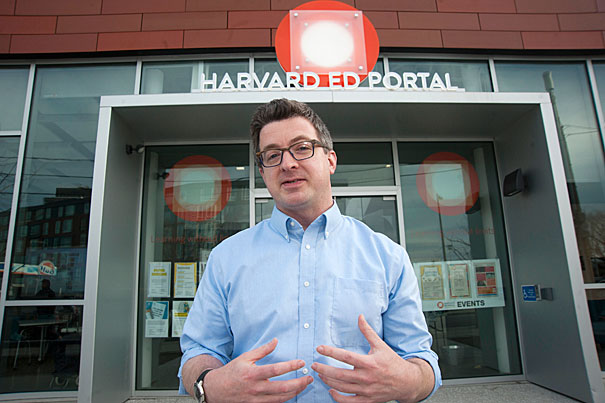The brain and how it learns may be among the most complicated puzzles in the quickly advancing field of neuroscience.
But Harvard is trying to unravel its mystery.
copyright by news.harvard.edu
The Ariadne Project, led by David Cox , an assistant professor of molecular and cellular biology and computer science at Harvard, mobilized a multi-university team of experts in neuroscience, physics, machine learning, and high-performance computing to explore the possibility of creating an artificial brain by reverse-engineering the brain of a rat while it learns. The aim is to build computer algorithms that replicate the way human brains perceive information and learn.
“This is where the field of computer science and neuroscience are not only exploding, but are merging on a collision course that is allowing us to explore the way we conventionally think of understanding,” Cox told 80 attendees at the Harvard Ed Portal’s Faculty Speaker Series lecture “ Toward an Artificial Brain ” in Allston.
“Walking across a room and not falling over is hard for a computer [robot], but easy for us.”
“Walking across a room and not falling over is hard for a computer [robot], but easy for us. Systems don’t quite understand the way we understand,” he said. “Let’s go back to the brain and find out what we’re missing.” Kenneth Blum , executive director of the Center for Brain Science (CBS) said in opening remarks that recent advances in artificial intelligence may indicate that intelligent machines are just around the corner. But how that might happen remains a question.
Moving from rats’ to human brains
“You have probably read about artificial intelligence in the news, seen it in movies, used Siri or Alexa or one of the other voice assistants … or know that soon in most cars to be sold there will be a little chip that will gather data to assist with self-driving cars,” he said. “But nobody thinks that simply massive computer power alone — which has driven all of these recent advances — will be enough to get us to magically understand real intelligence. That’s what we are going to hear from David tonight,” he said. Cox explained that by analyzing a rat’s brain activity, taking that brain apart, reconstructing the wiring, and mapping microscopic data, the Ariadne Project is paving the way on the artificial intelligence frontier.
read more – copyright by news.harvard.edu
Thank you for reading this post, don't forget to subscribe to our AI NAVIGATOR!


The brain and how it learns may be among the most complicated puzzles in the quickly advancing field of neuroscience.
But Harvard is trying to unravel its mystery.
copyright by news.harvard.edu
The Ariadne Project, led by David Cox , an assistant professor of molecular and cellular biology and computer science at Harvard, mobilized a multi-university team of experts in neuroscience, physics, machine learning, and high-performance computing to explore the possibility of creating an artificial brain by reverse-engineering the brain of a rat while it learns. The aim is to build computer algorithms that replicate the way human brains perceive information and learn.
“This is where the field of computer science and neuroscience are not only exploding, but are merging on a collision course that is allowing us to explore the way we conventionally think of understanding,” Cox told 80 attendees at the Harvard Ed Portal’s Faculty Speaker Series lecture “ Toward an Artificial Brain ” in Allston.
“Walking across a room and not falling over is hard for a computer [robot], but easy for us. Systems don’t quite understand the way we understand,” he said. “Let’s go back to the brain and find out what we’re missing.” Kenneth Blum , executive director of the Center for Brain Science (CBS) said in opening remarks that recent advances in artificial intelligence may indicate that intelligent machines are just around the corner. But how that might happen remains a question.
Moving from rats’ to human brains
“You have probably read about artificial intelligence in the news, seen it in movies, used Siri or Alexa or one of the other voice assistants … or know that soon in most cars to be sold there will be a little chip that will gather data to assist with self-driving cars,” he said. “But nobody thinks that simply massive computer power alone — which has driven all of these recent advances — will be enough to get us to magically understand real intelligence. That’s what we are going to hear from David tonight,” he said. Cox explained that by analyzing a rat’s brain activity, taking that brain apart, reconstructing the wiring, and mapping microscopic data, the Ariadne Project is paving the way on the artificial intelligence frontier.
read more – copyright by news.harvard.edu
Thank you for reading this post, don't forget to subscribe to our AI NAVIGATOR!
Share this: